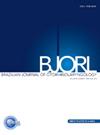Development and internal validation of risk stratification tool for lymph node metastasis in pT3-4 laryngeal squamous cell carcinoma patients
IF 1.7
4区 医学
Q2 OTORHINOLARYNGOLOGY
引用次数: 0
Abstract
Objective
To identify risk factors for Lymph Node Metastasis (LNM) in pT3-4 Laryngeal Squamous Cell Carcinoma (LSCC) patients with negative margins, and develop a nomogram to predict LNM risk.
Methods
872 patients were divided into training (2010–2014) and validation (2015–2016) cohorts. Univariate and multivariate analyses identified LNM risk factors. A nomogram incorporating significant factors was developed in the training cohort.
Results
Smoking history, maximal tumor diameter ≥3.0 cm, depth of tumor invasion >1.0 cm, and supraglottic tumor location were significantly associated with LNM on multivariate analysis. A predictive nomogram incorporating these factors showed good discrimination (C-index > 0.7) in both cohorts. Patients were stratified into low, moderate and high-risk subgroups based on total risk scores.
Conclusions
A LNM risk prediction model and risk grouping system was established, which may aid treatment selection for pT3-4 LSCC patients. The model and algorithm could help optimize neck management for this high-risk patient population.
Level of evidence
2.
pT3-4喉鳞状细胞癌患者淋巴结转移风险分层工具的开发与内部验证
目的方法:将872例患者分为训练组(2010-2014年)和验证组(2015-2016年)。单变量和多变量分析确定了LNM风险因素。在训练队列中绘制了包含重要因素的提名图:结果:在多变量分析中,吸烟史、肿瘤最大直径≥3.0厘米、肿瘤侵犯深度>1.0厘米和声门上肿瘤位置与LNM显著相关。包含这些因素的预测提名图在两个队列中均显示出良好的区分度(C 指数 > 0.7)。根据总风险评分将患者分为低、中和高风险亚组:建立了LNM风险预测模型和风险分组系统,可帮助pT3-4 LSCC患者选择治疗方法。该模型和算法有助于优化这一高风险患者群体的颈部管理:
本文章由计算机程序翻译,如有差异,请以英文原文为准。
求助全文
约1分钟内获得全文
求助全文
来源期刊

Brazilian Journal of Otorhinolaryngology
OTORHINOLARYNGOLOGY-
CiteScore
3.00
自引率
0.00%
发文量
205
审稿时长
4-8 weeks
期刊介绍:
Brazilian Journal of Otorhinolaryngology publishes original contributions in otolaryngology and the associated areas (cranio-maxillo-facial surgery and phoniatrics). The aim of this journal is the national and international divulgation of the scientific production interesting to the otolaryngology, as well as the discussion, in editorials, of subjects of scientific, academic and professional relevance.
The Brazilian Journal of Otorhinolaryngology is born from the Revista Brasileira de Otorrinolaringologia, of which it is the English version, created and indexed by MEDLINE in 2005. It is the official scientific publication of the Brazilian Association of Otolaryngology and Cervicofacial Surgery. Its abbreviated title is Braz J Otorhinolaryngol., which should be used in bibliographies, footnotes and bibliographical references and strips.
 求助内容:
求助内容: 应助结果提醒方式:
应助结果提醒方式:


